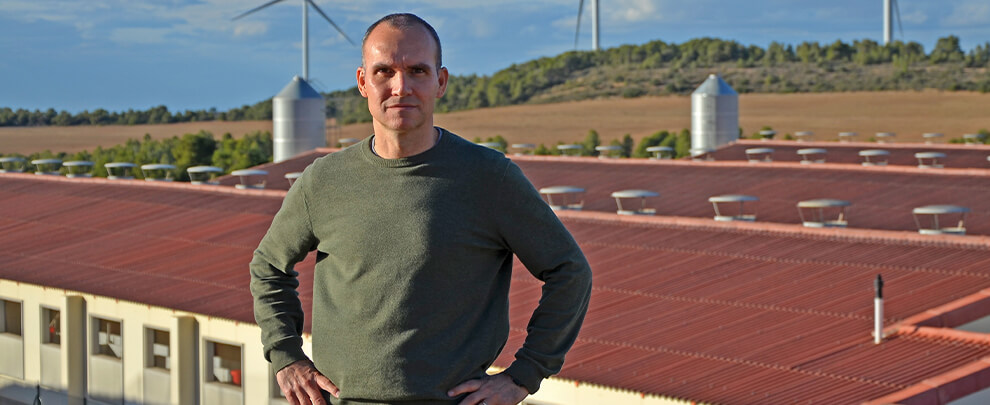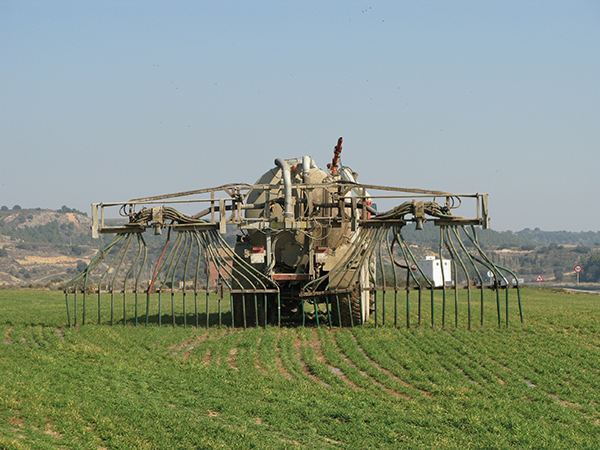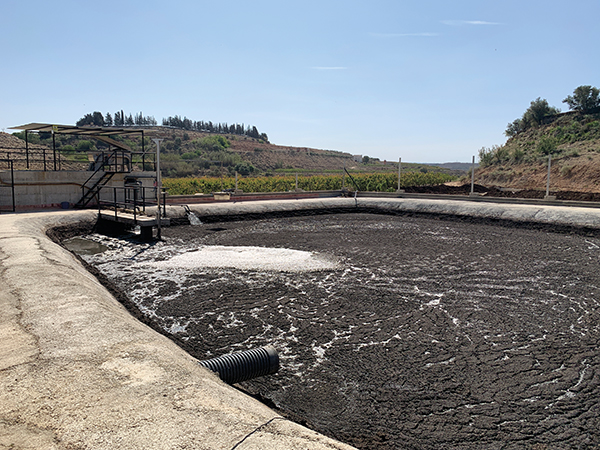Blog
Blog

J. Esquerda: "BAT are always technically and economically viable"
23 of January of 24 - News
One of the great challenges of the pig sector is to optimize slurry management and claim to be a sustainable and environmentally friendly sector. Poor management of livestock manure can have adverse effects on the environment and, ultimately, on people. Therefore, it is essential to know, analyze and evaluate the Best Available Techniques (BAT) for the sector, in order to comply with the emissions objectives established by European regulations. To analyze the impact of manure on the environment and the tools available to the sector to minimize it, we spoke with Juanjo Esquerda, technician from the General Directorate of Agriculture and Livestock of the Department of Climate Action, Food and Rural Agenda of the Generalitat of Catalonia.
What is approximately the amount of slurry production on Catalan pig farms?
In Catalonia, which is our area of action, about 12,000,000 m3 of slurry are produced per year, and we can say that the Catalan pig herd accounts for approximately 23% of Spanish pig production, so we can get an idea of the importance of correct management of livestock manure.
What has been done in recent years to reduce the amount of slurry produced?
Certainly, the amount of slurry per place has been progressively decreasing in recent years. This fact is due to several reasons, such as the improvement in pig feeding, the use of more efficient waterers, the optimization of pen cleaning and the improvement in their design. Currently, for example, in Catalonia, practically all pig farms use multiphase feeding techniques, supplying feed with a low crude protein content that takes into account the specific nutritional needs of the animals according to their age. This ensures that they assimilate the food better, improve the conversion rates, reduce the volume of slurry produced and that the excretion of nitrogen per square and year is considerably minimized, thus reducing the management needs of said slurry through its application on farmland or through treatment processes.
Despite these advances, slurry management continues to be one of the sector's great future challenges. Why?
The pork sector, like any economic sector, has to combine competitiveness and sustainability, and both concepts must go hand in hand. In 21st century Europe, the viability of a business that does not ensure its environmental sustainability is not conceivable. A crucial part of the sustainability of a livestock farm necessarily involves proper management of slurry, valuing it and understanding it as a resource that, well used, can add economic value to its environment. For example, manure is an excellent fertilizer if applied in the correct dose and at the right time that a crop requires, reducing emissions to a minimum through respectful techniques, which allow reducing and even eliminating the need for the use of chemical fertilizers, with the consequent economic savings for farmers and environmental savings for society.

Localized application of slurry through hanging tubes. Photo: DACC. Generalitat of Catalonia.
What must be taken into account to manage slurry?
Correct management of slurry must cover all phases of the process. This management begins with the use of techniques that minimize production on the farm, such as improvements in pig feeding or the use of waterers that reduce water losses. The next phase is its storage, which is of transcendental importance to reduce nitrate pollution in water bodies and reduce atmospheric emissions. And, finally, its correct valuation as agricultural fertilizer is very important. We must not forget that throughout this process other opportunities are generated, such as the production of biogas and its use in the livestock facilities themselves, for example, to heat the facilities, with the consequent economic savings for the farmer. In addition, the treatment of livestock manure also allows the manufacture of fertilizer products with commercial value, which can provide additional income for the farm.
What environmental effects does poor manure management have?
Without a doubt, poor management of livestock manure can have adverse effects on the environment and, ultimately, on people. When we talk about poor management, we are referring, for example, to what may occur during the storage phase of livestock manure. Having good facilities to store slurry is essential for its correct management. Its dimensions must be adequate to be able to store the slurry during periods of time in which it cannot be used as fertilizer on crops. Likewise, it is very important that storage systems are built with impermeable materials, to prevent slurry from contaminating the subsoil and underlying water masses. Another type of pollution is the emission of polluting gases into the atmosphere, such as ammonia (NH3) and greenhouse gases (GHG). Ammonia (NH₃) emissions represent a serious environmental problem, because ammonia can form PM2.5 particles that, if inhaled, can affect the respiratory and cardiovascular systems. According to the National Inventory of Atmospheric Pollutants, the Spanish agricultural sector (agriculture and livestock) generates 96% of ammonia emissions, of which 79% corresponds to livestock.
In order to minimize the environmental impact of slurry, Best Available Techniques have been implemented. Which of these BATs offer the best results?
A best available technique (BAT) is usually made up of several techniques that pursue the same objective, and each technique has a different pollution reduction capacity. In the case of ammonia, these techniques reduce its emission with respect to a reference value, which is given by the most unfavorable situation, that is, the one that emits the most ammonia into the atmosphere. For pig houses, the most unfavorable situation occurs when the house has a fully slatted floor, U-shaped pits and the manure is kept in the pits throughout the entire production cycle. In the case of ponds, the reference value is given in an open pond without a natural crust. The choice of one or another technique will depend, first of all, on the percentage of ammonia reduction that the farmer is obliged to achieve with respect to the value of the reference technique. For example, new slurry tanks must reduce their ammonia emissions by 80% compared to the reference technique, and the Guide to the Best Available Techniques published by MAPAMA in 2017 explains that techniques that achieve 80% reduction are rigid and flexible covers. However, if we had an existing tank whose required ammonia reduction was 40%, we could also use floating geometric pieces, which achieve a 60% reduction. In short, the choice of each technique will always be conditioned by the level of emissions reduction that must be achieved, and by other technical and/or economic factors, and we must not forget that the percentage of reduction is established in the regulations.

The natural scab technique has no associated cost. Photo: Rotecna.
Currently, most farms are applying BAT. Which are the most installed?
Inside the farms, probably the technique that is being used the most is the construction of V-shaped pits with emptying through the bottom of the pit into a collector, which collects the slurry and takes it to a pond or tank. This technique is recognized as reducing ammonia by 65% compared to the reference value. The philosophy to reduce ammonia inside the farms is to accumulate a very small amount of slurry in the pits and empty it very frequently into the ponds and tanks, which would have their own measures to reduce emissions such as, for example, the covers. In outdoor storage, if we are talking about new tanks that are required to reduce ammonia emissions by 80%, depending on the tank to be built, rigid or flexible covers will be used. In existing livestock farms that are only required to reduce ammonia emissions from their ponds and outdoor tanks by 40%, the natural crust technique would be useful, which has no associated cost. In any case, a recommendation would be to build more and more tanks and fewer ponds, since tanks are easier to cover and allow for better emissions management.
Are BATs a viable investment for livestock farmers?
In general yes, although there are factors that can influence the economic cost, such as the availability of materials or the difficulties in implementing BATs on the farm. BATs are considered the best alternative to carry out an activity in an environmentally friendly manner and are, by definition, technically and economically viable. That is, we can have a fantastic technique that allows us to greatly reduce pollution, but if it is not economically viable it will not be considered BAT. This does not mean that the implementation of BAT necessarily has to be cheap, but it must be taken into account that they are techniques validated and approved by official European organizations that have verified their technical and economic feasibility. And, finally, also consider that the requirements to reduce emissions are greater in new facilities than in existing ones.
What are the emissions reduction objectives that pig farms must meet?
The objectives for reducing ammonia emissions in Spanish pig farms are established in Royal Decree 306/2020, on pig management. For new farms (or warehouses), techniques must be used that reduce ammonia emissions by at least 60% with respect to the reference technique (total grating, U-shaped pits and slurry maintenance throughout the production cycle in the facility pits). In the case of external slurry storage, techniques must be adopted to reduce ammonia emissions by 80% with respect to the reference technique (open ponds without natural crust). For existing farms with a productive capacity greater than 120 UGM (equivalent to 1,000 fattening pigs), the obligation is established to empty the slurry pits at least once a month, and to additionally adopt other techniques such as increasing the frequency of emptying the slurry pits at least twice a week, with the aim of reducing polluting gas emissions by a minimum of 30% compared to the reference technique, or covering the slurry ponds in areas where they are not spontaneously form a crust that completely covers the surface, with techniques that reduce emissions of polluting gases by at least 40% compared to the reference of an open pond without a crust.
Is the sector ready to meet these objectives?
Spain has acquired international commitments to combat climate change, such as the United Nations Framework Convention on Climate Change (UNFCCC) and the Paris Agreement, the Geneva Convention or Air Convention on Long-Distance Transboundary Pollution, the Gothenburg Protocol relating to acidification, eutrophication and tropospheric ozone, etc. Likewise, there are European directives that force Spain to reduce said pollution. In this sense, larger farms that have integrated environmental authorization had until February 21, 2021 to adopt measures and implement BAT. For the rest of the farms, the measures to reduce ammonia emissions came into force on January 1, 2023, so the majority of farms have been implementing the BAT, and the Administration has to ensure that this is the case. However, a challenge that the Spanish intensive livestock sector has is to find the best BAT that adapts to the conditions of Spanish livestock farming. It must be taken into account that the reduction of emissions and the development of techniques to reduce them have been issues led by northern countries. This means that some BAT are very difficult to apply on our farms, since the design conditions of the buildings or, simply, the environmental conditions are very different from those of those countries.






